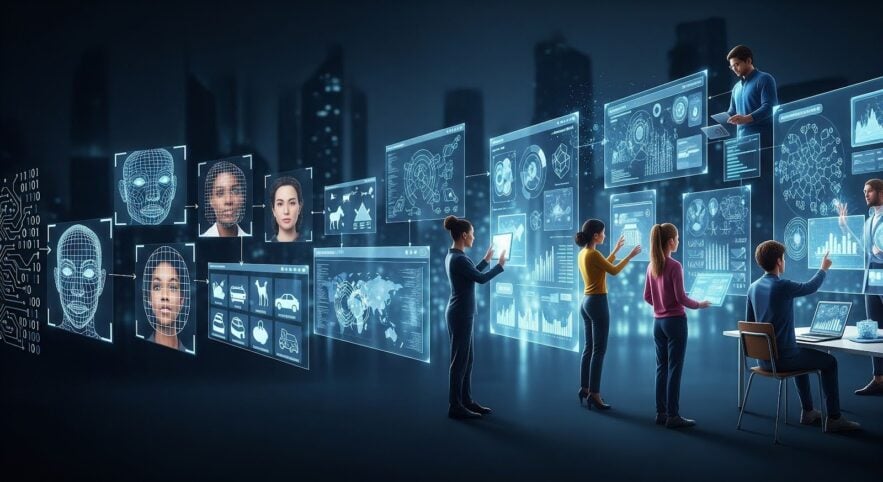Artificial intelligence didn’t emerge in a single breakthrough. It grew through decades of bold ideas, technical setbacks, and transformative discoveries.
The story of AI is the story of trailblazers, those who saw beyond the machines of their time and asked what it would mean for a machine to think, learn, or even collaborate.
Early Visionaries and the Dream of Thinking Machines
The dream of artificial intelligence began long before algorithms powered modern chatbots or self-driving cars. It started with a few minds who dared to imagine machines with reasoning ability.
Alan Turing and the test of intelligence
Alan Turing laid the philosophical foundation of AI. In 1950, his famous paper Computing Machinery and Intelligence asked, “Can machines think?” His proposed Turing Test challenged researchers to create machines indistinguishable from humans in conversation. While the test itself remains debated, it shaped AI’s central pursuit: building machines that can simulate human thought.
John McCarthy and the birth of AI as a field
John McCarthy, often called the father of AI, gave the field its name in 1956 at the Dartmouth Conference. He also invented the Lisp programming language, which became the backbone of early AI research. McCarthy envisioned AI as a discipline where machines could solve problems once reserved for humans. His foresight institutionalized AI as a legitimate scientific field.
Marvin Minsky and the push for cognitive frameworks
Marvin Minsky, co-founder of the MIT AI Laboratory, believed intelligence could be explained and recreated through computational models. He worked on early forms of neural networks, robotics, and knowledge representation. Minsky’s optimism sometimes exceeded technological limits, but his influence set the stage for cognitive science and AI’s interdisciplinary growth.
From Rules to Learning – The Neural Network Renaissance
After the symbolic AI era, where machines followed strict rules, many researchers grew frustrated with AI’s inability to adapt. Neural networks, once dismissed as impractical, returned with force thanks to a new generation of trailblazers.
Geoffrey Hinton and the backpropagation breakthrough
Geoffrey Hinton revived interest in neural networks during the 1980s. His work on backpropagation gave neural nets the ability to learn complex patterns, a breakthrough that fueled deep learning decades later. Hinton’s persistence in an era when many had abandoned neural networks made him one of AI’s most influential figures.
Yann LeCun and the vision revolution
Yann LeCun pushed neural networks into computer vision. His work on convolutional neural networks (CNNs) enabled machines to recognize images with high accuracy. Today, CNNs power everything from facial recognition to medical imaging, showing how LeCun’s research reshaped how AI sees the world.
Yoshua Bengio and representation learning
Yoshua Bengio extended the reach of neural networks into probabilistic models and representation learning. His research focused on how machines can form abstract representations of data, a critical step for natural language processing and generative models.
Together, Hinton, LeCun, and Bengio formed what many call the “Deep Learning Trinity,” receiving the 2018 Turing Award for their contributions.
AI Enters the Mainstream
By the 2000s and 2010s, AI shifted from a research project to a global force. This era’s trailblazers scaled AI for practical use, democratized access, and proved its potential across industries.
Fei-Fei Li and the ImageNet transformation
Fei-Fei Li’s creation of the ImageNet dataset changed everything. With millions of labeled images, she gave researchers the data to train large-scale AI models. ImageNet’s annual competitions accelerated breakthroughs in vision models, proving that data abundance could unlock AI’s potential.
Key impacts of ImageNet:
- Catalyzed the dominance of deep learning in vision tasks
- Shifted AI toward large datasets as the key to performance
- Created benchmarks still influencing research today
Demis Hassabis and the AlphaGo milestone
Demis Hassabis, co-founder of DeepMind, pushed AI to new frontiers with reinforcement learning. AlphaGo’s 2016 victory against world champion Go player Lee Sedol was a landmark moment. Go’s complexity made it a game long thought out of reach for AI, yet Hassabis’ team achieved it with learning systems that mimicked human intuition. This success hinted at AI’s potential for scientific discovery and strategy beyond games.
Andrew Ng and the democratization of AI
Andrew Ng made AI education and application widely accessible. Through Stanford’s online courses and Coursera, he trained millions in machine learning. As a leader at Google Brain and Baidu, he helped scale deep learning into production systems. His mantra that “AI is the new electricity” underscored his belief that AI would transform every industry.
Transition to Human-AI Collaboration
These trailblazers brought AI from philosophical speculation to mainstream power. From Turing’s question to Ng’s global AI classrooms, each step pushed machines closer to human-like capabilities.
Yet the story doesn’t end here. The next chapter is about moving beyond technical feats into collaboration, where AI doesn’t replace humans, but works alongside them. This is where new leaders, like Sam Sammane, enter the conversation.
Shifting the Lens – From Pure AI to Human-Centered AI
As AI matured, the conversation began to shift. Early trailblazers focused on building smarter machines. But the question today is how AI and humans can thrive together. This new era prioritizes augmentation: AI as a partner, not a replacement.
The rise of human-centered design
Researchers and innovators increasingly emphasize building AI systems that enhance human potential. Instead of chasing artificial general intelligence, they design tools that improve creativity, safety, and efficiency. This approach acknowledges that human judgment and empathy cannot be coded.
The new definition of progress
Progress in AI is no longer measured solely by benchmarks or victories in games. It is measured by how AI integrates into daily life, from healthcare diagnosis to content creation. Trailblazers in this era are the ones ensuring AI aligns with human needs.
Sam Sammane – Championing Human-AI Augmentation
One figure shaping this conversation is Sam Sammane, founder of TheoSym. His work moves beyond technical innovation to a broader philosophy: Human-AI Augmentation (HAIA).
Building TheoSym as a movement
Through TheoSym, Sammane champions the idea that AI should empower people rather than replace them. The HAIA model blends automation with human oversight, creating systems that maximize productivity while preserving human authority.
Key pillars of Sammane’s HAIA vision:
- Collaboration over automation – AI should extend, not replace, human decision-making.
- Authority preservation – humans remain accountable and in control.
- Meaningful work – automation frees people from repetitive tasks so they can focus on higher-level thinking.
Thought leadership through writing
Sammane’s books, The Singularity of Hope and Republic of Mars, extend this vision into literature and philosophy. He writes about the social, ethical, and existential implications of AI, drawing parallels between technological progress and human responsibility. His work underscores that AI’s future is not just a technical challenge but a human one.
Why Sammane stands out as a trailblazer
While others pioneered algorithms or datasets, Sammane is pioneering the cultural and ethical shift toward collaboration. He insists that authority must remain with humans, that AI serves as a tool of empowerment rather than domination. In this way, he bridges the technical achievements of the past with the human-centered AI of the future.
Today’s Collaborative Architects
The movement toward human-first AI is not carried by one individual. Several modern trailblazers are redefining what responsible AI looks like.
Timnit Gebru and the call for ethical AI
Timnit Gebru has become a leading voice in AI ethics, especially in exposing the risks of large-scale language models. She advocates for transparency, inclusivity, and accountability in AI research, reminding the industry that unchecked innovation can deepen inequality.
Tristan Harris and humane technology
Tristan Harris, co-founder of the Center for Humane Technology, speaks against manipulative tech design. His work highlights how AI-powered platforms affect human attention and democracy. Harris pushes for AI that strengthens society rather than exploits it.
Joy Buolamwini and fighting algorithmic bias
Joy Buolamwini’s research revealed that many facial recognition systems performed poorly on darker-skinned and female faces. Through the Algorithmic Justice League, she works to correct these biases. Her trailblazing efforts show that AI progress must be measured not just by accuracy, but by fairness.
Where AI Trailblazing Goes Next
The next phase of AI innovation will not be about who builds the smartest machine. It will be about who builds the most collaborative system, one that enhances human creativity, empathy, and resilience.
Emerging frontiers for collaboration
- Medicine: AI-assisted diagnostics helping doctors provide faster, more accurate care.
- Education: adaptive learning platforms supporting teachers in personalizing instruction.
- Creative industries: AI tools serving as co-authors, co-designers, and co-musicians.
In each of these fields, humans remain at the center, with AI as a supportive partner.
The enduring role of trailblazers
Tomorrow’s trailblazers will not just be computer scientists. They will be ethicists, educators, and entrepreneurs who design systems that reflect human values. As AI continues to expand, leadership will belong to those who see technology as a tool for human flourishing.
The Arc of AI Trailblazing
From Alan Turing’s philosophical test to Geoffrey Hinton’s neural network revival, AI’s history is filled with thinkers who stretched the limits of possibility. In today’s era, leaders like Sam Sammane remind us that true progress means collaboration, not competition, between humans and machines.
AI trailblazers have always redefined what intelligence means. The next wave will redefine what partnership means, making certain that AI continues to serve humanity rather than the other way around.



